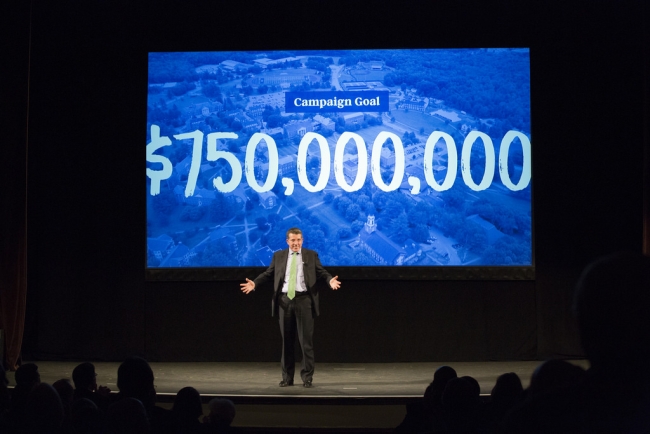You have /5 articles left.
Sign up for a free account or log in.

Robert E. Diamond is co-chairing Colby College's campaign.
Colby College
The co-chair of Colby College’s recently announced $750 million fund-raising campaign puts remarkably little emphasis on its end date.
“If you had picked up the phone and asked me, ‘Bob, what is the end date of the campaign?’ I would say, ‘I’m not sure,’” said Robert E. Diamond, a former chair of Colby’s Board of Trustees and current trustee who is co-chairing the campaign. “In all the discussions we had, I think that probably got less discussion than anything else.”
The college does have an end date in mind -- officials have been saying the campaign will last six more years, although they have yet to announce a specific closing date. Leaders of the campaign say they have focused on its ambitiousness and its goals instead of its deadline. When the campaign was announced in October, Colby noted it was the largest ever undertaken by a liberal arts college and listed the ways money raised will go toward academic programs, access and new facilities.
Such emphases aren’t unusual for major campaigns at colleges and universities. But Colby stands out for how little attention it has drawn to its campaign’s eventual ending. The college’s campaign stands out for another reason as well: it was only in a silent phase, the critical period in which officials court big-name donors to build momentum, for a year. It’s common for colleges to spend several years in quiet phases, raising large sums toward their total campaign goals.
Those points can be attributed in part to Colby’s unique history. However, they also reflect trends affecting higher education fund-raising more generally. Many institutions are careful in what they emphasize as they court different groups of donors and use their campaigns to meet an ever-widening variety of goals. Many are also currently having success securing pledges from their big-name donors thanks to flush times and years of grooming.
Colby, a 2,000-student college in Waterville, Me., that ranks among the country’s oldest private liberal arts institutions, had raised more than $380 million toward its $750 million goal when it officially launched the campaign Oct. 20. The college said it had received 32 contributions totaling at least $1 million each. Such large donations are an important part of meeting the lofty fund-raising goals that colleges and universities are frequently chasing.
The percentage of its goal Colby raised before going public isn’t unusual. Raising large sums before publicly launching a campaign allows institutions to decide where to set their final goals, line up the biggest patrons they’re likely to find, demonstrate some momentum and catch the attention of other prospective donors.
What is most unusual about Colby’s announcement is the single year spent in a silent phase. It was possible in part because strong stock market performance has put wealthy donors in a position to give and in part because the college had prepared for the campaign with a message that resonated.
“This is Colby’s moment, and the environment is conducive,” Diamond said.
Diamond chaired Colby’s Board of Trustees when its last campaign ended, in 2010. That campaign raised $376 million in a five-year effort, exceeding its goal by $6 million.
The college learned from its previous campaign, Diamond said. He also attributed the early fund-raising success this time around to ambitious work by Colby’s president, David A. Greene, who took over in 2014.
Greene has pushed for Colby to grow closer to Waterville and invest in the city, Diamond said. He has also shared a vision for operating Colby as one of the world’s top liberal arts institutions. A Colby goal is to use the campaign to “continue to redefine the liberal arts.”
Major gifts already announced will go toward residential and mixed-use space, a center for arts and innovation, an institute for American art, an athletic complex, and a new program to make internships, research opportunities or other global experiences a financial possibility for every student.
A number of pieces came together at the same time, Greene said.
“Our global programs were really starting to develop quickly, and then our revitalization of Waterville and our efforts to really be engaged in that in a deep way were moving at a pace that was faster than we had anticipated originally,” he said. “It was really starting to come to life in a way that it felt like the time was probably right to take this public.”
Taking the campaign public early was an opportunity to have more time to spread Colby’s message at a time when its academics and admissions are strong, Greene added.
“I thought having six years of that communication platform instead of five years would be better for us over all,” he said.
Other timing issues could play into early campaign launches, experts said. With the uncertainty of federal tax reform hanging over development offices and philanthropists, many may feel an incentive to give this year while the tax environment is still predictable. With stock markets continuing to rise, it’s time to strike while the iron is hot.
Experts also say that short silent phases can reflect colleges’ fund-raising operations becoming more advanced. Many colleges and universities have gotten much better at knowing which donations are in the pipeline and which donors are close to signing up for a big gift.
“We’ve seen people using their data,” Dena Schwartz, a senior analyst with the Advancement Forum at EAB. “They do a screening to figure out what their donor pool looks like. They do know who their big donors are.”
One fund-raising campaign can build momentum for another, Schwartz said. So well-run past campaigns can help new campaigns be successful more quickly in the future.
Colby’s wide range of ambitious goals is in character with many of today’s major fund-raising campaigns. In some cases, a wide range of goals is a reason institutions are de-emphasizing campaign end dates.
The goals aren’t always public facing. Sometimes they are about signing up new donors who have not previously given.
“We’re seeing more and more schools plan campaigns without publicizing that end date because they have lots of goals in mind that aren’t necessarily that dollar goal on paper,” Schwartz said. “They talk about engagement goals. They talk about young alumni donors. They need the flexibility to achieve that over time.”
For example, millennial donors aren’t necessarily motivated to give by a particular end date the way other generations have been, Schwartz said. She also noted that colleges and universities find themselves competing with many causes to win young donors’ money. The fund-raising environment today is more competitive than it has been in the past, so some institutions might need wiggle room to meet their goals.
Colby is attempting to re-engage a group of donors who may not have heard from the college recently, said Anne Clarke Wolff, a Colby trustee and vice chair of the campaign. She said the college has had difficulty engaging with donors who graduated in the 1970s and 1980s, around the time Colby was unsettled by its disbanding fraternities in 1984.
Many alumni from those generations are playing leading roles in this campaign, so she is hopeful that the efforts will prove successful.
“What we don’t know is the time it will take to re-engage that broader community with the campaign and, more importantly, what’s going on at Colby,” she said. “Maybe that education, re-engagement, cultivation, will take a little bit longer. Maybe it will be shorter.”
Since Colby launched the campaign in October, its total raised has climbed from $380 million to $387.9 million. The college will hold a New York City launch for the campaign Dec. 6.
Data sets on campaign end dates are relatively scarce, but Council for Aid to Education surveys indicate that institutions sometimes launch campaigns without determined end dates. Still, experts say a campaign launched without officials having any end date in mind would be uncommon. The Council for Advancement and Support of Education recommends comprehensive campaign periods not exceed eight years. Doing so helps to maximize the efforts of volunteers, donors and staff members, according to the organization’s reporting standards. It also keeps fund-raising campaigns aligned with institutions’ priorities.
Colby isn’t alone in not directly emphasizing a campaign end date. Rensselaer Polytechnic Institute announced a $1 billion campaign in October. The university’s official announcement made no note of an end date, although President Shirley Ann Jackson had previously written about the coming campaign enabling a strategic plan called the Rensselaer Plan 2024.
The RPI campaign is planned to end in 2024, a spokeswoman said. The institute has not specifically chosen to de-emphasize the campaign end date, she said, but instead wants to focus on other elements of the effort.








